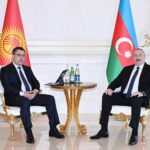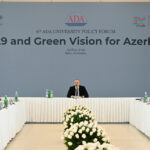Armenia has Armenianized ancient Albanian churches in Karabakh. Azerbaijan has an extensive scientific knowledge base on this issue, but I would still like to know your opinion on how Albanian churches came to be in the region and whether Azerbaijanis are considered heirs of Caucasian Albania.
The real name of Caucasian Albania is Arran. In Azerbaijani, Georgian, Iranian, Turkish, Syrian and other medieval sources it is given as “Arran” and “Arran Church”. The name “Albania” came from ancient Greek and Roman sources, and then the terms “Caucasian Albania” and “Albanian Church” appeared in modern European science. These terms are still used today in European languages to differentiate it from Albania in Europe. The state of Arran, or Caucasian Albania, is one of the ancient states in the region of South Caucasus, one of the first to adopt Christianity as a state religion. In the 4th century, Urnayr, king of Caucasian Albania of the Arshakid dynasty, together with his elite, nobility and people adopted Christianity. It began to spread in Caucasian Albania as early as in the 1st century through Jesus’s preaching disciples, but it did not become the state religion until the 4th century.
As for the matter of succession, the peoples of Caucasian Albania are the ancestors of the modern Azerbaijani people and other peoples of the region. Therefore, Azerbaijan is considered the successor of the cultural and historical heritage of Caucasian Albania.
The truth is that before the adoption of Islam, a significant part of our region practiced Christianity, or rather, Diophysite, Albanian Christianity. And many cultural elements, the historical heritage were passed down and preserved in our people from generation to generation. Part of this heritage belongs directly to Caucasian Albania. However, its direct heirs are the Udis, who have partially preserved their beliefs, culture and, most importantly, language. Azerbaijanis and other peoples are also successors, but the Udis are considered the direct heirs, as they have preserved a significant part of the rituals, cultural and, above all, the spiritual heritage of Caucasian Albania and its church.
When did Armenians first start claiming Albanian churches as their own?
The Armenian Church was very different in the Middle Ages from what we know it to be today. The Monophysite, or Armenian Gregorian Church was composed of numerous congregations of different ethnic backgrounds. In other words, these peoples, these communities belonged to different ethnicities and were not what is called today the Armenian Hay, or Haykan people. These different communities were subordinated to different religious centers. In the Caucasus, one of these centers was the Ararat Church or, as it was later called, the Church of Echmiadzin. And the struggle between Armenian and Albanian churches essentially began in the Middle Ages. Unfortunately, the Albanian Church and its people were losing the fight century after century to the Armenian Church, which relied on various empires and rulers to enslave and appropriate the heritage of the Albanian Church, that is, the temples and cultural and historical heritage of the peoples of Caucasian Albania.
This process reached certain limits in the 8th century, after the region was conquered by the Arabs. But the Albanian church and state were able to partially persevere and preserve their uniqueness. The Albanian church and state found a new lease of life in the support from the Oghuz Turks during the Seljuk conquests and the mass migration of Kipchaks to our region, and it is largely through this that the Albanian church was able to survive.
The heyday of Albanian culture, church and statehood occurred approximately in the 12th-13th centuries, when one of the Albanian rulers Hasan Jalal Dola established an Albanian state, a principality called Khachen Atabegs, which directly indicates the Turkic roots of this state and its subordination to the Atabegs of Azerbaijan. Many names, including those of Hasan Jalal himself, his wife, close relatives, indicate that they were of Turkic origin. However, numerous wars gradually led to the weakening of Hasan Jalal’s Albanian state until it began to fall under the influence of the church of Echmiadzin around the 15th-16th centuries.
It is known that during the period of the Azerbaijani Qara Qoyunlu ruler Jahan Shah in the mid-15th century, the Armenian Church was allowed to move from Cilicia to the territory of the Caucasus. And in the place of the former Albanian temples, Uchkilse, the Armenian patriarchate gradually began to take over the Albanian heritage. This process was at its most intense in the 17th-18th centuries and became even more pronounced with the growing influence of tsarist Russia in the region.
Undoubtedly, the most tragic page in the history of the Albanian Church was at the beginning of the 19th century, after the arrival of tsarist Russia in the Caucasus. It led to the gradual abolition of the Albanian Church and the subordination of its churches and congregation to the Church of Echmiadzin. Tsarist Russia strengthened the role of the Armenian Church in the region, and almost the entire heritage of the Albanian Church was taken over by the Armenian Church during the 19th and early 20th centuries; the congregation and the people were forced to adopt the Armenian Gregorianism, to submit to the Armenian Church and, consequently, to be Armenianized. Meanwhile, a large part of the Albanian congregation, including some of the Udis and other peoples, converted to Islam and mixed with the Azerbaijani people to save their cultural heritage. A small part of the Udis refused to adopt Armenian Gregorianism and tried to preserve their former faith despite persecution. This is how the Udis were able to preserve their culture and partially their spiritual heritage, and now they are reviving their church.
What do you think is the goal of the Armenian side pursuing by calling the Albanian churches Armenian?
By appropriating the Albanian heritage, the Armenian Church aims to make the presence of the Armenian people in our region seem more ancient. A total appropriation of Albanian temples began in the nineteenth century. New inscriptions in the Armenian church language were carved on these temples, khachkars were placed everywhere and the Armenian communities relocated from Iran, Turkey and the Middle East during that period appropriated the entire Albanian heritage.
Since the Armenians were close to the Albanian church in terms of denomination, this process of appropriation was easy for Echmiadzin. By falsifying the appearance of Albanian temples, destroying or falsifying Albanian manuscripts and heritage, Armenian nationalists eventually began to lay claim to the entire region, arguing that Armenians are one of the ancient peoples of the Caucasus, that the Armenian church is the most ancient in the region, and that Albanian heritage and culture, even if they existed before, had long been part of the Armenian heritage and church.
What language did the Caucasian Albanians speak?
There are still debates about this. It is known that it was a conglomerate of different peoples. According to ancient sources, Arran, or Caucasian Albania, was a union of 26 peoples who spoke different languages. Therefore, we cannot speak of a common Albanian language. Preserved palimpsests and Albanian lectionary from the 5th century and even later were found in Saint Catherine’s Monastery on the Sinai Peninsula in Egypt. Some of them were deciphered. The surface of the palimpsests was rubbed out and other inscriptions were written on them. But thanks to modern technology the lower layer of inscriptions was restored. Thus, the original writings emerged and the entire Albanian Christian lectionary was restored.
The vocabulary of the Albanian language is largely composed of Udi words and words of other Caucasian peoples. It also has a very significant amount of Turkic words, which are also preserved in the Azerbaijani language. One needs only to read the main prayer of all Christians, “Our Father”, from the 5th century lectionary in the Albanian church language to find many words that are familiar to us, for example, “Tanri”—”Lord”, or “algysh”, and other words. This shows that from the earliest times the Albanian church and people absorbed the Turkic culture, which means that Turkic peoples played a very important role in the ethnogenesis, in the formation of culture and spiritual identity of the Albanian church and people.
What do you think of Azerbaijan’s initiative to remove fake Armenian inscriptions on Albanian temples?
Of course, this is a good and right thing to do, and it makes sense that the falsifier, Armenia, is concerned about this. All these years the Armenian side justified its ideology and pseudo-antiquity with falsified temples, including those in Karabakh. It is very important that Azerbaijan succeeded in having a separate UNESCO mission sent to Armenia to study the Azerbaijani Muslim medieval heritage as well. Mosques, caravanserais, fortresses and other Azerbaijani heritage in the territory of modern Armenia were completely destroyed. Another UNESCO mission in Karabakh will study the Azerbaijani, Muslim and Christian heritage destroyed by Armenians, including the Albanian churches, which were destroyed, appropriated and falsified.
For my part, I would like to say that for some time now the Center for the History of the Caucasus, which brought together a group of foreign scientists and experts, UNESCO representatives, has been conducting research in the territory of Azerbaijan. And in the future, our experts and likeminded people will be only too happy to continue this activity in the liberated territories of Azerbaijan.
Huseyn Safarov
Translated from Caliber.Az
Aze.Media










